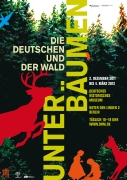

Forest Violence
The forest under National Socialism
The timber deliveries to France laid down in the Treaty of Versailles in 1919 and the French occupation of densely wooded areas fortified the belief held by many Germans that the “arch enemy” aimed to use all means to wipe out the Reich. In this same period an old idea regained importance: its advocates recommended the forest as “educator”.
This idea of “forest education”, developed in the 19th century, was founded on the concept of a “forest community”. With its alleged “fitting” vegetation, determined by “selection” and “right of the strongest”, it was to become the model for a society in which inequality and expulsion determined everyday life.
In their programmes and their rule from 1933 on, the National Socialists fell back on such concepts. The forest became the model for the “Volksgemeinschaft”, the community of the people. It served as a legitimization, supposedly based on natural law, for racial fanaticism and for the occupation and annihilation of all “forest enemies”, now meaning above all Jews and Slavs.
